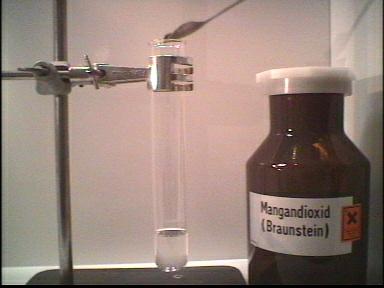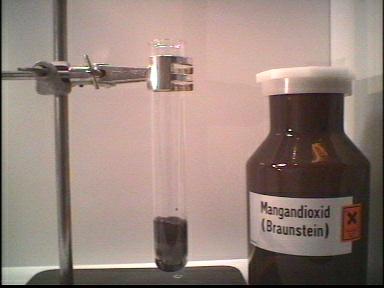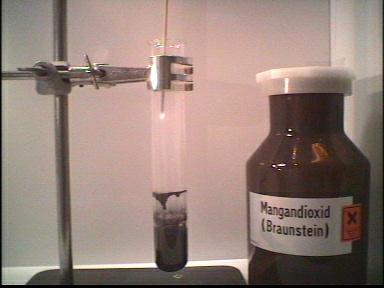



| 1. |  |
2. |  |
| Experimental setup: 3% hydrogen peroxide solution and manganese dioxide | Addition of manganese dioxide | ||
| 3. |  |
4. |  |
| Glowing splint test for oxygen | Oxygen is detected |
| Photo 1: | Experimental setup: A spoonful of manganese dioxide is dropped into a test tube containing 3% hydrogen peroxide solution. |
| Photo 2: | Immediately following the addition of manganese dioxide, the hydrogen peroxide decomposes into water and oxygen. |
| Photo 3 + 4: | Oxygen is tested for using a glowing splint. The ember flares; the test is positive. |
The reaction shown here is an example of a heterogeneous catalyst. Hydrogen peroxide is thermodynamically unstable. However, the speed at which it decomposes into water and oxygen is quite low. The manganese dioxide, present as a solid, increases the rate of decomposition of the hydrogen peroxide in the solution, whereas the manganese dioxide itself is not used up in the reaction. Thus, it has no influence on the reaction per se, only on the rate at which it takes place (catalyst).
When the catalyst is not in the same phase as the reaction products,
it is called a "heterogeneous catalyst." Well-known examples of heterogeneous
catalysts are catalytic converters in cars and the synthesis of ammonia
from its elements.
| Exercise 5.7.1.:
Solution |
Hydrogen peroxide decomposes to the first order. The speed law for
a first-order reaction is:
c(A) = c0(A)×e-kt What is the halftime t1/2 at which half of c0(A) has been transformed? |